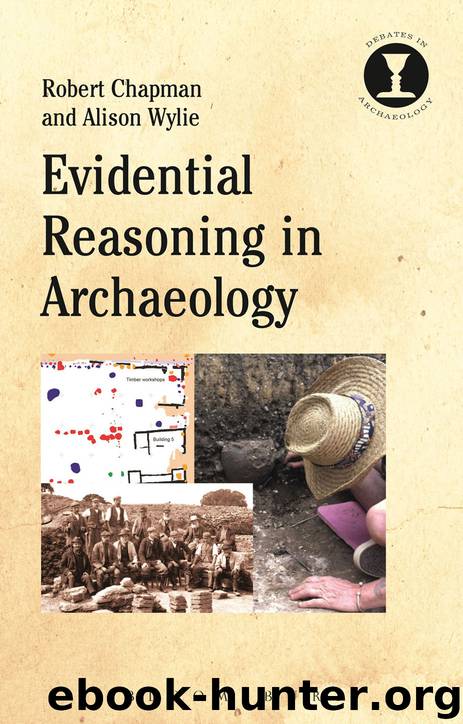Evidential Reasoning in Archaeology by Robert Chapman Alison Wylie

Author:Robert Chapman,Alison Wylie
Language: eng
Format: epub
Publisher: Bloomsbury UK
Published: 2016-03-14T16:00:00+00:00
Figure 3.7 Comparison of (left) Clarke’s ‘speculative’ environmental reconstruction of the Glastonbury Iron Age village territory and (right) Aalbersberg and Brown’s most recent palaeoenvironmental reconstruction. (Sources: adapted from Clarke 1972b: Fig. 21.7, and Aalbersberg and Brown 2011: Fig. 1b.)
Coles and Minnitt also questioned Clarke’s four-phase model of the occupational history of Glastonbury. Like Barrett, they noted a number of problems with the site stratigraphy as reported by Bulleid and Gray and drew the implication that, because Clarke had given no clear indication of which floors within mounds he attributed to specific phases, his phasing for the site as a whole was problematic. Using the stratigraphic data they had assembled from the archival as well as the published report, they reanalysed the relationships between individual structures (pp. 110–15); the result was a four-phase sequence, but one that differed from Clarke’s. Evaluating new radiocarbon dates, including those from other local sites, in relation to ‘typological dating’ of pottery, metal and glass objects from the wider region of southern England, they concluded that the site had been occupied nearly twice as long as Clarke had suggested (c. 250–50 bce).
Finally, and perhaps most consequentially, Coles and Minnitt reassessed Clarke’s claims about relational patterns – horizontal, artefactual and structural conjunctives – that constitute the foundational evidence for his claim that the basis for the organization of the site as a whole, through time, was a modular social, architectural unit. Tracing his relational models back to the primary data he cites, they found that his distinctions between types of structure and his claims about their co-occurrence as components of a module are empirically unsustainable. For example, there is much less consistency in the structural attributes of the ‘major’ houses and much greater variation in their artefact associations than claimed by Clarke; indeed, on re-examination, some of them proved not to exist (pp. 183–7). In several cases the minor houses did not exist at the same time as the major houses with which they were associated in Clarke’s account. Only one of the seven ‘baking huts’ Clarke had identified fits his definition of this type of structure, and the ‘guard huts’ lacked the structural and artefactual features he had attributed to them. There was also no evidence of ‘repeated burial of butchered horse skeletons in and around’ the structures he identified as ‘stables/byres’. While Coles and Minnitt raised few problems with the ‘clay patches’ and the ‘granaries/storehouses’ of Clarke’s model, they argued that the mound central to the site that he had identified as sufficiently wealthy to justify the inference that it housed a ‘headman’ was most likely not a house (Mound 42), and they pointed out that there was no concentration in this central area of material indicative of wealth such as decorated pottery, ornaments and weaving combs. This was an issue that Courbin had raised in particularly sharp terms, observing that the only basis for Clarke’s ‘untested’ headman’s house hypothesis was a series of ‘assertions’ about ‘a mound which, while bigger than the others, seems to
Download
This site does not store any files on its server. We only index and link to content provided by other sites. Please contact the content providers to delete copyright contents if any and email us, we'll remove relevant links or contents immediately.
| Anthropology | Archaeology |
| Philosophy | Politics & Government |
| Social Sciences | Sociology |
| Women's Studies |
Mysteries by Colin Wilson(3394)
People of the Earth: An Introduction to World Prehistory by Dr. Brian Fagan & Nadia Durrani(2701)
Ancient Worlds by Michael Scott(2622)
Foreign Devils on the Silk Road: The Search for the Lost Treasures of Central Asia by Peter Hopkirk(2433)
The Splendid and the Vile by Erik Larson(2354)
The Memory Code by Lynne Kelly(2352)
Come, Tell Me How You Live by Mallowan Agatha Christie(2212)
Lost Technologies of Ancient Egypt by Christopher Dunn(2194)
The Earth Chronicles Handbook by Zecharia Sitchin(2179)
The Plantagenets by Dan Jones(2038)
Last Chance to See by Douglas Adams(1933)
The Return of the Gods by Erich von Daniken(1895)
Wars of the Anunnaki by Chris H. Hardy(1681)
Keeper of Genesis by Graham Hancock(1607)
Before the Dawn by Nicholas Wade(1575)
The Cygnus Mystery by Andrew Collins(1520)
The Message of the Sphinx by Graham Hancock(1482)
Fragile Lives by Stephen Westaby(1421)
Hieroglyphs: A Very Short Introduction by Penelope Wilson(1312)
